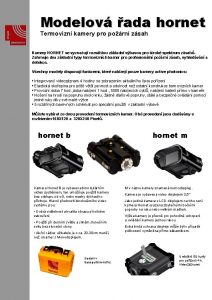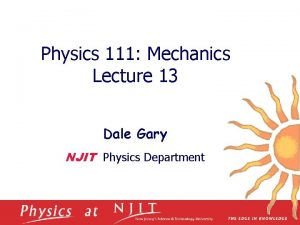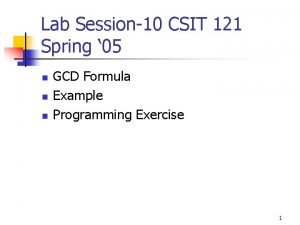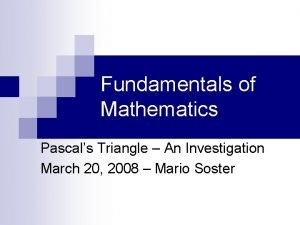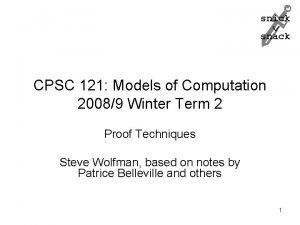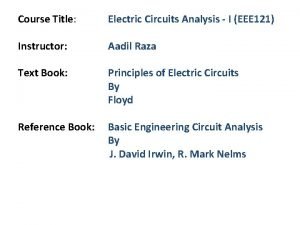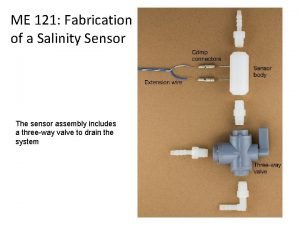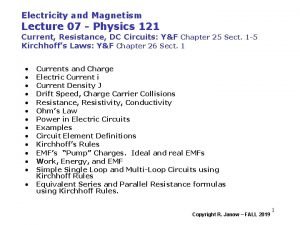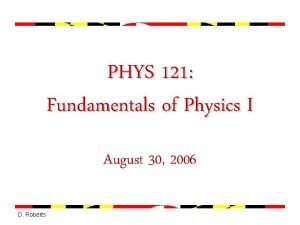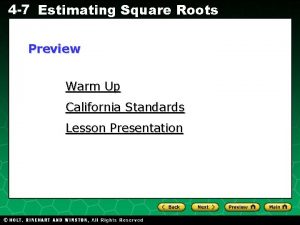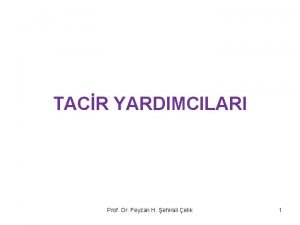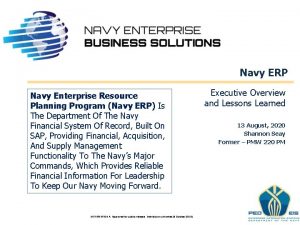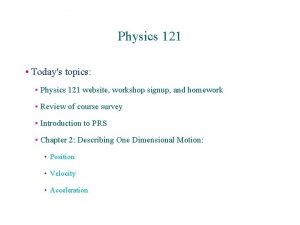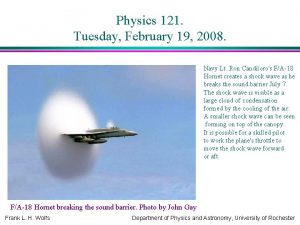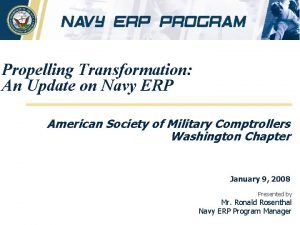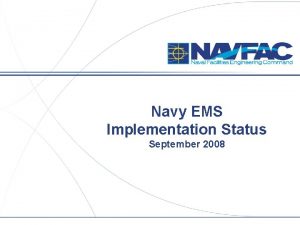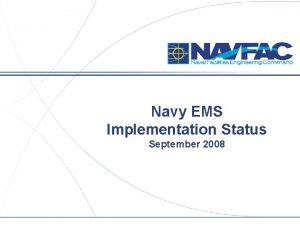Physics 121 Navy Lt Ron Candiloros FA18 Hornet



























- Slides: 27

Physics 121 Navy Lt. Ron Candiloro's F/A-18 Hornet creates a shock wave as he breaks the sound barrier July 7. The shock wave is visible as a large cloud of condensation formed by the cooling of the air. A smaller shock wave can be seen forming on top of the canopy. It is possible for a skilled pilot to work the plane's throttle to move the shock wave forward or aft. F/A-18 Hornet breaking the sound barrier. Photo by John Gay

Physics 12 • Topics: • Course announcements • Work and Energy: • Definition • Work done by a Variable Force • Kinetic Energy

Physics 121 Course Announcements • On Thursday February 17 between 9: 40 and 10: 55 the first midterm exam of Physics 121 will be held. The material covered on the exam is the material covered in Chapters 2 - 6 of our text book. • A few remarks about the exam: • You can bring 1 “cheat sheet” which needs to be handed in with the solutions (it need to carry your name and student id #). • You can bring a calculator. • I can’t gauge difficulty of exam (I am sorry you are guinea pigs). There are 16 problems (many do not require a calculator), and 6 true/false and some concept questions. • Alternate exam today (1: 00, meet at my office). For students who have talked to me well in advance and only under extreme circumstances. • LAS students take exam at the LAS (Pam Spallacci).

Physics 121 Course Announcements • Notes for next week: • The exam will take place in class. • Our class period on Tuesday will remain at its normal time slot (contrary to what is indicated in the course information). • Students who normally go to workshops on Tuesdays are encouraged to attend one of the other workshops if they have questions related to the exam.

Physics 121 Course Announcements • There will be no homework set due this week. • Homework set # 4 is outside my office • The most effective way to work on the assignment is to tackle 1 or 2 problems a day (6 days with 1 problem a day, and 1 day with 2 problems). • Contact your TA with problems (website has all of the office hours listed for all of the TAs. You are welcome to any of their office hours.

The Solar System • The perturbation from pure elliptical orbits were a result of the gravitational attraction between the planets. • Detailed measurements of these perturbations led to the discovery of e. g. Neptune and Pluto. Bill Arnett, http: //seds. lpl. arizona. edu/nineplanets/arnett. html

Work and Energy • We now leave the world of astronomy, and get back to earth. • In the next few weeks, we will not discuss any new physics, but develop tools to simplify how we use our understanding of the force laws and the laws of motion to understand and/or predict the outcome of experiments. • We will start with defining the concept of work and the concept of energy.

Work and Energy • When a force F is applied to an object, it may produce a displacement d. • The work W done by the force F is defined as where f is the angle between the force F and the displacement d.

Work • Consider the definition of W: • The work done by the force F is zero if: • d = 0 m (no displacement) • f = 90° (force perpendicular to the displacement).

Work Positive, Zero, or Negative • Work done by a force can be positive, zero, or negative, depending on the angle f: • If 0° ≤ f < 90° (scalar product between F and d > 0) the speed of the object will increase. • f = 90° (scalar product between F and d = 0) the speed of the object will not change. • If 90° < f ≤ 180° (scalar product between F and d < 0) the speed of the object will decrease.

Work Units • The unit of work is the Joule (abbreviated J). • Per definition, 1 J = 1 Nm = 1 kg m 2/s 2. • There are many important examples of forces that do not do any work. For example, the gravitational force between the earth and the moon does not do any work! Note: in this case, the speed of the moon does not change.

Power • In many cases, the work done by a tool is less important than the rate with which the work can be done. • For example, explosive devices get their properties from being able to do a lot of work over a very short period in time. The same amount of work done over a longer period of time might not lead to destruction.

Power Units • Power of defined as work per unit time: • The unit of power is the Watt, abbreviated by a W. • Per definition: 1 W = 1 J/s = 1 kg m 2/s 3 • The power you consume at home is often expressed in terms of k. Wh, which is the use of 1 k. W of power for 1 hour.

Work An Example: The Problem A block of mass M is drawn at constant speed a distance d along a horizontal floor by a rope exerting a force F at angle q above the horizontal. Compute (a) the work done by the rope on the block, and (b) the coefficient of kinetic friction between block and floor.

Work An Example: Step 1 • The requirement that the object moved with constant speed tells us that the net force acting on it must be 0 N. • Thus the net forces in the x and y directions: ……. . must be zero.

Work An Example: Step 2 • The normal force N can be determined based on the fact that the net force in the vertical direction must be zero: • Based on the fact that we now know normal force N we can determine the frictional force f (kinetic friction since the block is moving):

Work An Example: Step 3 • The friction force is also directly related to the applied force F by considering net force in the horizontal direction, which has to be zero. • This requires that • The work done by the friction force is negative (since direction and displacement are in opposite direction):

Work An Example: Step 4 • The work done by the applied force F is equal to • The net work done (due to the applied force and the friction force) is equal to zero. • This is not really a surprise …. since the net force on the object is equal to zero.

Work Done by a Varying Force • In most realistic cases, we need to consider the work done when the force is varying (both in magnitude and direction) as function of time and/or position. • In this case, we can still use the same approach as we just discussed by breaking up the motion into small intervals such that the path is linear and the force is constant during the intervals considered.

Work Done by a Varying Force

Work. A Final Remark. Do Less Work by Thinking before Starting! • Consider the work done by all forces acting on the pendulum when it moves from position 1 to position 2. • During this motion, the angle between the path and the net force changes. What am I to do?

Work-Energy Theorem • We have already seen that there is a connection between the work done by a force and the change in the speed of the object: • If W > 0 J: speed increases • If W = 0 J: speed remains constant • If W < 0 J: speed decreases

Work-Energy Theorem • Consider the bus starting from rest (v 1 = 0 m/s) and having an acceleration a = F/m. The velocity at a later time t will be equal to • This relation can be used to determine the time t at which the bus reaches a certain velocity v: t = v/a.

Work-Energy Theorem • The displacement at this time t is equal to • The work done by the force F during this period is equal to Kinetic Energy K

Work-Energy Theorem • We conclude: The net work done on an object is equal to the change in its kinetic energy. • In the case of the bus: Fnetd = 0. 5 mv 22 - 0. 5 mv 12

Work-Energy Theorem An Application • An object with mass m is at rest at time t = 0 s. It falls under the influence of gravity through a distance h. What is its velocity at that point? • Solution: • Work done by the gravitational force = mgh. • Change in kinetic energy = 0. 5 mv 12. • Work-Energy theorem: mgh = 0. 5 mv 12 or v 1 = √(2 gh)

That’s all! Next week: Conservation of Energy. Unusual Spherules on Mars Credit: Mars Exploration Rover Mission, JPL, USGS, NASA
 Hornet piroliza
Hornet piroliza Eco hornet
Eco hornet Hornet porn
Hornet porn Njit kepler
Njit kepler Physics 121 njit
Physics 121 njit Modern physics vs classical physics
Modern physics vs classical physics University physics with modern physics fifteenth edition
University physics with modern physics fifteenth edition Ib physics ia example
Ib physics ia example Csit 121
Csit 121 Csc 121
Csc 121 Ap-141
Ap-141 Druhá odmocnina znak
Druhá odmocnina znak Pascals identity
Pascals identity Cpsc 121
Cpsc 121 Psalm 121 1 3
Psalm 121 1 3 Metacognicin
Metacognicin Eee 121
Eee 121 Me 121
Me 121 Resistivity depends on
Resistivity depends on Phys 121 umd
Phys 121 umd Isd-121
Isd-121 Icrp 121
Icrp 121 Lmt 110
Lmt 110 Lmt 121
Lmt 121 Uci computer science major
Uci computer science major Evaluate 144/121
Evaluate 144/121 Philip ritchey tamu
Philip ritchey tamu Simsar nedir ttk
Simsar nedir ttk


